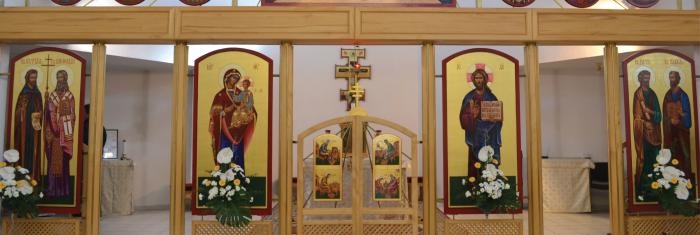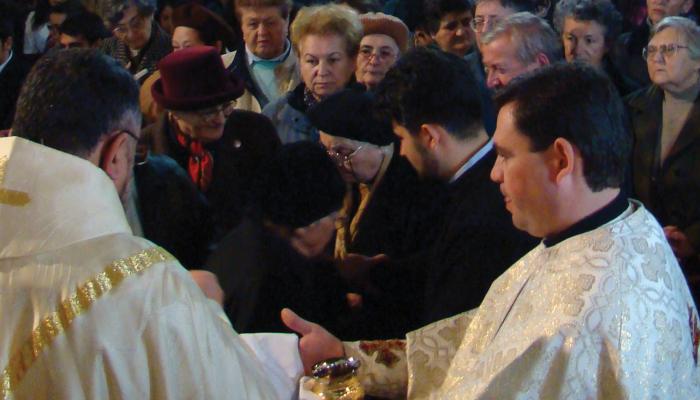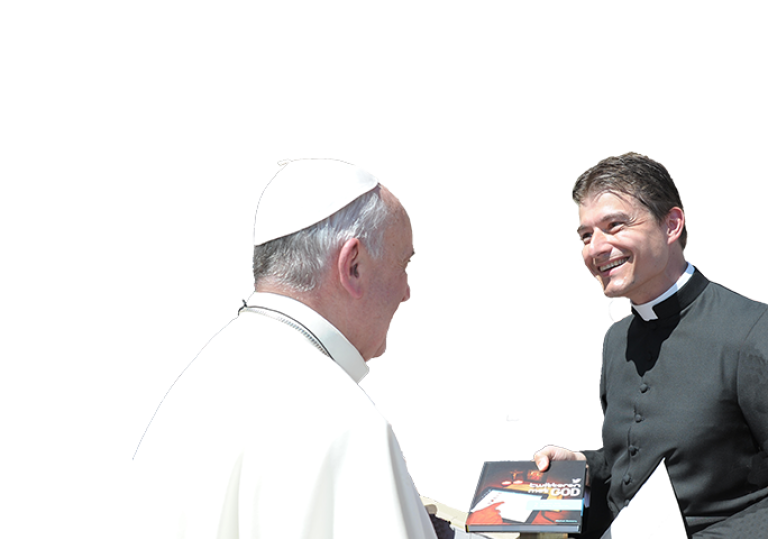
3.52 Wat is het verschil tussen roomse en byzantijnse katholieken?
Latijnse en Byzantijnse katholieken hebben precies hetzelfde geloof. De verschillen zitten vooral in de kerkelijke architectuur, in dagelijkse christelijke gewoonten, en in de manier waarop het geloof en de sacramenten gevierd worden. Zo worden bijvoorbeeld het doopsel, de Eerste Heilige Communie en het vormsel allemaal ontvangen op het moment van geloofsinitiatie. Een ander verschil is dat Oosterse priesters getrouwd kunnen zijn.
Veel gebruiken en vormen van liturgie in de Byzantijnse Ritus komen overeen met de Oosters Orthodoxe traditie. Echter, in tegenstelling tot de Orthodoxen, maken de Grieks-Katholieken volledig deel uit van de Katholieke Kerk. Het liturgische jaar kan verschillen waar Oosterse Kerken de Juliaanse kalender (25 vChr) blijven gebruiken, terwijl de Westerse kerk de meer gebruikelijke Gregoriaanse kalender (1582 AD) volgt.
How does the Church on earth celebrate the liturgy?
The Church on earth celebrates the liturgy as a priestly people in which each one acts according to his proper function in the unity of the Holy Spirit. The baptized offer themselves in a spiritual sacrifice; the ordained ministers celebrate according to the Order they received for the service of all the members of the Church; the bishops and priests act in the Person of Christ the Head. [CCCC 235]
How is the liturgy celebrated?
The celebration of the liturgy is interwoven with signs and symbols whose meaning is rooted in creation and in human culture. It is determined by the events of the Old Testament and is fully revealed in the Person and work of Christ. [CCCC 236]
What is the purpose of holy images?
The image of Christ is the liturgical icon par excellence. Other images, representations of Our Lady and of the Saints, signify Christ who is glorified in them. They proclaim the same Gospel message that Sacred Scripture communicates by the word and they help to awaken and nourish the faith of believers. [CCCC 240]
What is the function of the liturgical year?
In the liturgical year the Church celebrates the whole mystery of Christ from his Incarnation to his return in glory. On set days the Church venerates with special love the Blessed Virgin Mary, the Mother of God. The Church also keeps the memorials of saints who lived for Christ, who suffered with him, and who live with him in glory. [CCCC 242]
What is the most profound origin of the liturgy?
The most profound origin of the liturgy is God, in whom there is an eternal, heavenly banquet of love – the joy of the Father, the Son, and the Holy Spirit. Because God is love, he would like to let us participate in the feast of his joy and to grant us his blessings.
Our earthly liturgies must be celebrations full of beauty and power: Feasts of the Father who created us – that is why the gifts of the earth play such a great part: the bread, the wine, oil and light, incense, sacred music, and splendid colors. Feast of the Son who redeemed us – that is why we rejoice in our liberation, breathe deeply in listening to the Word, and are strengthened in eating the Eucharistic Gifts. Feasts of the Holy Spirit who lives in us – that is why there is a wealth of consolation, knowledge, courage, strength, and blessing that flows from these sacred assemblies. [Youcat 170]
What is the essence of every liturgy?
Liturgy is always in the first place communion or fellowship with Jesus Christ. Every liturgy, not just the celebration of the Eucharist, is an Easter in miniature. Jesus reveals his passage form death to life and celebrates it with us.
The most important Liturgy in the world was the Paschal liturgy that Jesus celebrated with his disciples in the Upper Room on the night before his death. The disciples thought that Jesus would be commemorating the liberation of Israel from Egypt. Instead, Jesus celebrated the liberation of all mankind from the power of death. Back in Egypt it was the “blood of the lamb” that preserved the Israelites form the angel of death. Now he himself would be the Lamb whose blood saves mankind from death. For Jesus’ death and Resurrection is the proof that someone can die and nevertheless gain life. This is the genuine substance of every Christian liturgy. Jesus himself compared his death and Resurrection with Israel’s liberation from slavery in Egypt. Therefore, the redemptive effect of Jesus’ death and Resurrection is called the Paschal mystery. There is an analogy between the life-saving blood of the lamb at the Exodus of the Israelites from Egypt (Ex 12) and Jesus, the true Paschal Lamb that has redeemed mankind from the bondage of death and sin. [Youcat 171]





